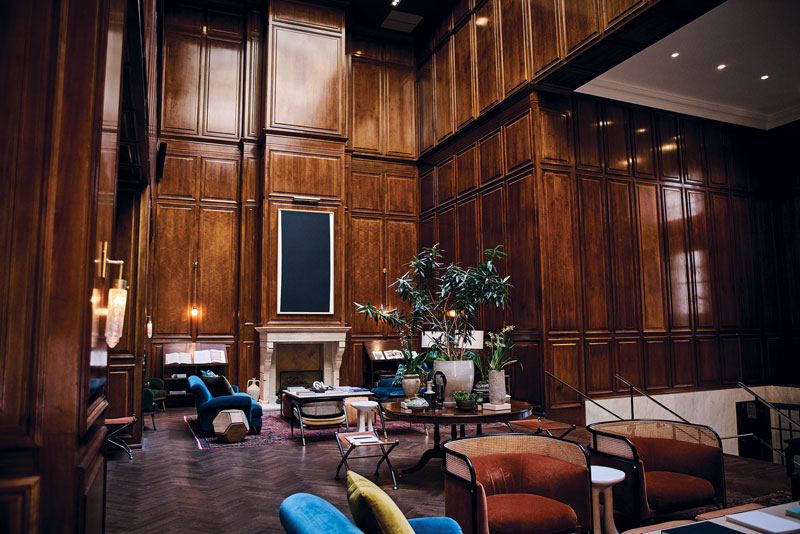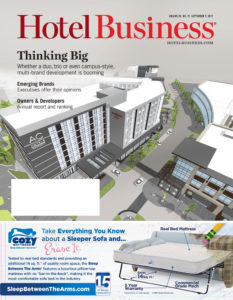NATIONAL REPORT—Communal spaces in hotel lobbies often mirror the hustle and bustle of our daily lives: Colleagues poring over reports while sipping lattes, friends bonding at the lobby bar with pints of beer and wings, kids watching a Disney movie on an iPad while their parent works on a laptop nearby—all of these are common occurrences in the hotel lobby today. The mobile world has increased just that—mobility—with guests looking to get out of their rooms and live, work and play in more social environments. Hotels have adapted their offerings to fill this need—but how will this trend evolve?
Patrick Hatton, GM of the Chicago Athletic Association Hotel, noted it’s all about choice. “Guests can choose to work in their room or in an activated shared space,” he said. “It’s up to the guest how they interact with the space.”
Kraig Kalashian, principal of Kraig Kalashian Architecture & Design, said that this choice continues in the shared space. “It might be something as simple as having spaces that are more secluded and quiet versus ones that serve food and are more active,” he said.
GM Tauseen Malik agreed that different zones are important, noting that at his hotel, The Adolphus in Dallas, two lobbies were designed to offer two experiences. “The lower lobby, steps away from registration, has a curated library ideal for solo guests looking for quiet reflection and people watching. The upper lobby is more engaging and dynamic—it provides multiple areas designed for work or socializing,” he said.
Garry Cox, GM of the Axiom Hotel, added, “We’re in the heart of San Francisco, so in order to get our guests to interact with these spaces, we knew the importance of offering multiple engaging activities, high-speed fiber-optic WiFi and a comfortable social environment,” he said. “We make this possible by layering our lobby and the cloud with wired communal tables for working, group seating arrangements for socializing, large-scale TVs, classic arcade games and board games.”
And social isn’t enough—communal spaces must be photo-worthy, said Marilyn Miller, director of sales and marketing, Radisson Blu Mall of America in Minneapolis. “In our experience, the most popular communal spaces are those that foster Instagram-worthy photos,” she said, noting that design elements—hanging basket chairs, a selfie mirror—were included for this purpose.
So what’s the key to success? “It’s important to have a heightened level of design detail both in aesthetics and in functionality to lend itself to the new uses of the communal spaces,” said Kimberly Terry-LeDoux, director of sales and marketing, The Blackstone, Autograph Collection in Chicago. For his part, Kalashian added, “The challenge is always to create something that feels like home while making sure it can withstand commercial traffic.”
Aside from design, outlets and internet access are a must. “Installing outlets at a bar is a great way to keep people who want to have a bite and do business,” said Sandi Robinson, director of sales, The Godfrey Hotel Chicago.
Her counterpart at The Godfrey Boston, Paul Sauceda, added, “The key ingredient is to offer an area where people feel comfortable, not just physically, but in terms of the atmosphere. It’s important guests feel that this is where they’re allowed to meet, talk and be themselves; it should feel welcoming and not formal or hushed.”
And local exposure is crucial. “The presence of locals is critical to creating a true local experience,” Hatton said. “In order to drive local use of the space, it must be easily accessible with a good balance of lighting, music and action, great (and free) internet and the opportunity to engage with others or work privately. This requires seating options that satisfy multiple needs. There also needs to be interesting ‘distractions’ for those who need a moment away from their project—art, books, etc.”
As with any space, there are ways to do communal lobbies well and ways to get it wrong. Terry-LeDoux said hotels shouldn’t overdue F&B offerings as “social lobby spaces are focused on more casual interactions versus a traditional lounge,” while Cox noted that hotels shouldn’t “pipe in music that is repetitive or too specific to one demographic.”
“The space should have music at just the right volume; not too loud to counter conversation, and not too soft to make guests feel like they need to whisper,” Sauceda added. “You’ve achieved the right atmosphere when your guests express that the lobby feels like the living room to their upstairs guestroom.”
From a designer’s perspective, Kalashian said, “The emphasis on putting TVs everywhere is something that many guests are repelled by. People can usually get whatever information they want on their phones, so TVs blasting news makes it difficult to have conversations and great experiences.”
“Over-congestion of the lobby with too many elements can disrupt the flow of guest traffic or the check-in process. Having too many design details and over-styling isn’t helpful or conducive for guests,” said Malik, noting that the trend toward communal spaces has lent itself to shrinking guestroom size, which is a potential concern.
Another thing to consider? Staffing. “The design and shift in functionality of interactive lobbies have necessitated a change in staffing,” Malik added. “Fully trained staff is needed whether that be skilled bartenders and empathetic servers, or creating positions such as our lobby ambassador who focuses on the overall experience.”
Hatton added, “In the evening, particularly in hotels with heavy local traffic, when the space transforms from mobile office to a social setting, we have to be more diligent in welcoming overnight guests and helping them navigate the convergence of checking in and an inviting social scene.”
How will this trend develop? “I see hotels dedicating over 50% of their lobby to communal spaces,” Robinson said. “They will add more electric outlets, long tables, sofas and have natural light. Small groups will have a favorite lobby like they have a favorite coffee shop, and they will be one in the same. More places will have frequent buyers clubs. If you can continue to bring a group of people to a space that historically brought $0 revenue, those guests should be rewarded for being loyal.”
For his part, Malik said, “The future of the social lobby will have a few different forms. Notably, with technological advances, lobbies will offer more office-like spaces and will become more tech friendly, and design elements in lobbies will capitalize on social media engagement. The next-gen lobby will also reflect the local culture, engaging local artists in the design.”
Cox foresees the extinction of the front desk. “It will be replaced by whatever tomorrow’s travelers want: curbside check-in, bar check-in, lounge check-in… It’s all about allowing guests to choose what they are most comfortable with. After all, we are their hosts.”
“Whatever the next-gen demographic wants will be reflected in how hotels design their lobby,” Sauceda agreed. “Accommodating the trends and desires of travelers is reflected directly through the lobby experience. Today’s generation is wired, they are social multitaskers and they like open work environments. Lobbies of the future may expand to be even more multipurpose, possibly infiltrating the hotel gym, retail and workplace components into the already versatile coffee shop, bar, lounge lobby fusions we see today. The hotel is a traveler’s micro-world when they’re on the road, so integrating all components into this space is only natural.” HB


